The intelligence failures during the Yom Kippur War show how vital it is to innovate with AI in military analysis. Israeli analysts relied on outdated assumptions and inductive reasoning, leading to severe misjudgments about enemy capabilities. AI could enhance intelligence operations by analyzing vast data and improving threat detection, ensuring a proactive approach rather than a reactive one. Understanding these lessons reveals the importance of embracing new technologies for national security. You'll find even more insights ahead.
Key Takeaways
- AI can analyze vast data efficiently, reducing information overload and improving real-time threat detection, addressing past intelligence failures.
- Machine learning algorithms can identify patterns in adversary communications, enhancing understanding of their intentions and capabilities.
- Proactive intelligence strategies powered by AI can anticipate threats, moving beyond the reactive measures that failed during the Yom Kippur War.
- Enhanced data integration through AI can synthesize human, signals, and open-source intelligence for a comprehensive threat landscape.
- AI-driven collaboration between Israeli and U.S. agencies can improve threat assessments, fostering collective security and operational readiness for future challenges.
The Historical Context of the Yom Kippur War

As tensions simmered in the Middle East, you might wonder how the Yom Kippur War, which erupted on October 6, 1973, caught Israel off guard.
This intelligence failure stemmed from the Israeli military intelligence's (AMAN) dogmatic belief in Arab unpreparedness, leading to a flawed analysis of military capabilities.
The surprise attack by Egypt and Syria shattered these misconceptions, highlighting significant shortcomings in understanding adversary intentions.
The Agranat Commission later examined these failures, revealing how reliance on outdated assumptions resulted in devastating consequences, including the deaths of about 2,500 Israeli soldiers.
Historical insights from the Yom Kippur War now emphasize the necessity for critical analysis and structured methodologies, ensuring that similar oversights aren't repeated in future conflicts.
Overview of Intelligence Failures in 1973

Despite clear signs of impending conflict, Israeli military intelligence (AMAN) failed to recognize the seriousness of the situation leading up to the Yom Kippur War.
This intelligence failure stemmed from an underestimation of Arab military capabilities and a rigid reliance on inductive reasoning, which led analysts to dismiss warning signs.
The Agranat Commission later pinpointed critical flaws in AMAN's analytical methods, revealing a dogmatic belief in Israel's military superiority.
Analysts also overlooked shifts in Egyptian strategy, contributing to a lack of preparedness.
The war resulted in approximately 2,800 Israeli casualties, highlighting the tragic consequences of these oversights.
This underscores the urgent need for improved analytical methodologies in military intelligence to better interpret emerging realities.
Lessons Learned From the Agranat Commission
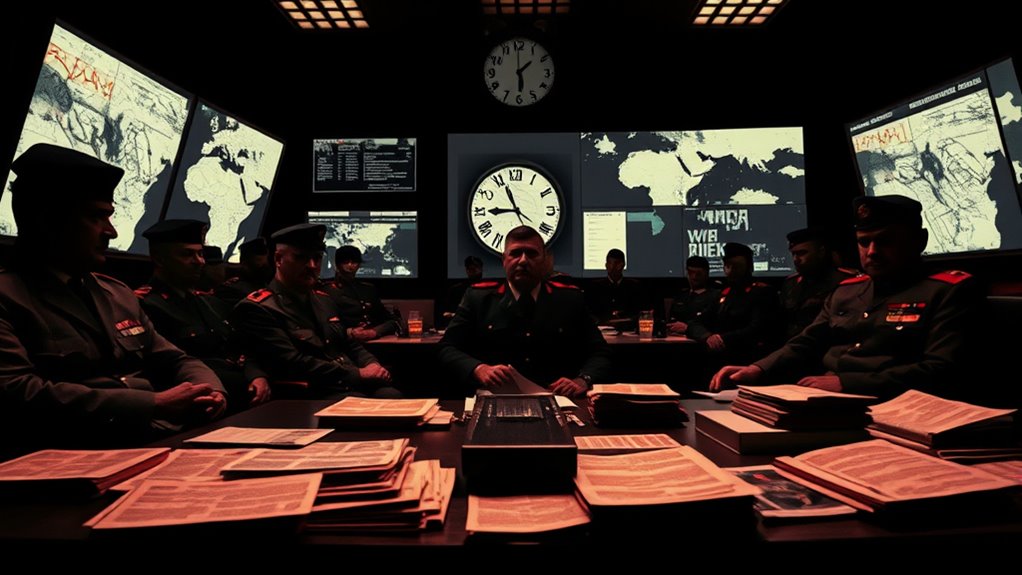
The Agranat Commission's findings offer vital lessons for intelligence organizations, highlighting key shortcomings that must be addressed to prevent future failures.
It points out that Israeli military intelligence relied too heavily on inductive reasoning and intuition, urging the adoption of structured analytical methodologies for more accurate intelligence assessments.
The Commission also recommends ending IDI's monopoly on national intelligence, advocating for enhanced analytical capacities across agencies like Mossad.
By fostering a culture of critical thinking, organizations can combat groupthink and guarantee diverse analytical perspectives.
A coherent definition of adversary intentions and capabilities is essential to improving strategic and early warning systems, ultimately enhancing the effectiveness of intelligence operations and preventing similar intelligence failures in the future.
The Role of Inductive Reasoning in Intelligence Analysis
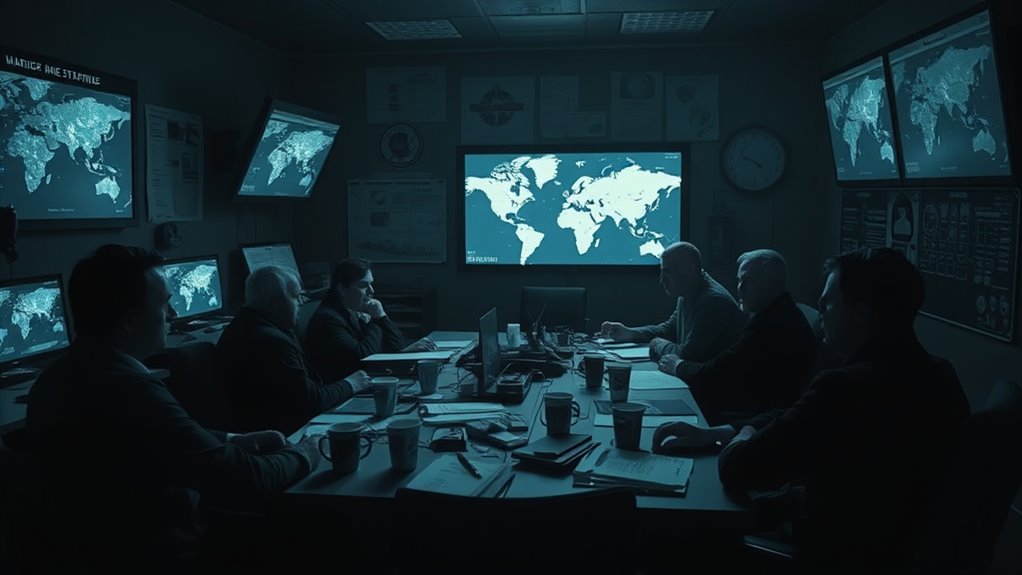
While inductive reasoning can be a valuable tool in intelligence analysis, its misuse can lead to significant misjudgments, as demonstrated during the Yom Kippur War.
Israeli intelligence relied heavily on past successes, allowing preconceived notions to cloud their analysis. They failed to recognize Egypt's strategic shift towards a surprise attack, reflecting a lack of structured analytical methods.
The Agranat Commission criticized this dogmatic reliance on inductive reasoning, emphasizing the need for critical thinking and a contrarian approach. By not challenging emerging indicators of imminent conflict, analysts limited their ability to adapt to changing threats.
Incorporating these structured methods could have enhanced intelligence accuracy, preventing the devastating miscalculations that occurred during the war.
Misjudging Adversary Intentions and Capabilities
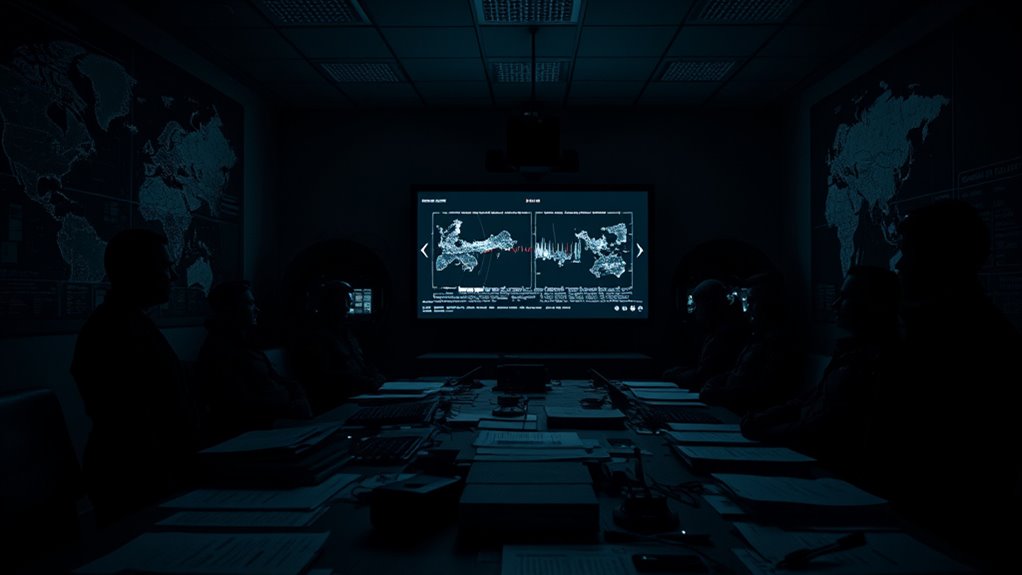
As Israeli intelligence assessed the situation leading up to the Yom Kippur War, it became increasingly evident that misjudgments about adversary intentions and capabilities would have dire consequences.
Israeli analysts, relying on inductive reasoning rather than structured analytical methods, failed to recognize key warning signs. They erroneously believed in Arab military unpreparedness, underestimating Egypt's strategic capabilities.
The Agranat Commission pointed out how these intelligence failures stemmed from a narrow focus on past successes, leading to critical misinterpretations of enemy strategies.
U.S. intelligence mirrored these errors, failing to challenge the rational actor fallacy. This lack of thorough analysis led to a disastrous underestimation of the coordinated attack's likelihood, highlighting the need for more robust intelligence practices.
The Impact of Complacency on Intelligence Assessments

Complacency in intelligence assessments can severely undermine national security, as seen in both the Yom Kippur War and the recent Hamas attack on October 7, 2023.
Israeli intelligence's overconfidence in past operational successes fostered a dangerous culture, leading to critical misjudgments about Hamas's capabilities. The Agranat Commission post-Yom Kippur highlighted how complacency results in intelligence failures, stressing the need for structured analytical techniques to challenge dogmatic beliefs about adversary capabilities.
When intelligence assessments rely too heavily on advanced technology without incorporating critical thinking, they risk overlooking crucial information. This failure to adapt methodologies and confront existing assumptions about the enemy can have dire consequences, jeopardizing national security and operational success against evolving threats like Hamas.
The Potential of AI in Enhancing Intelligence Operations
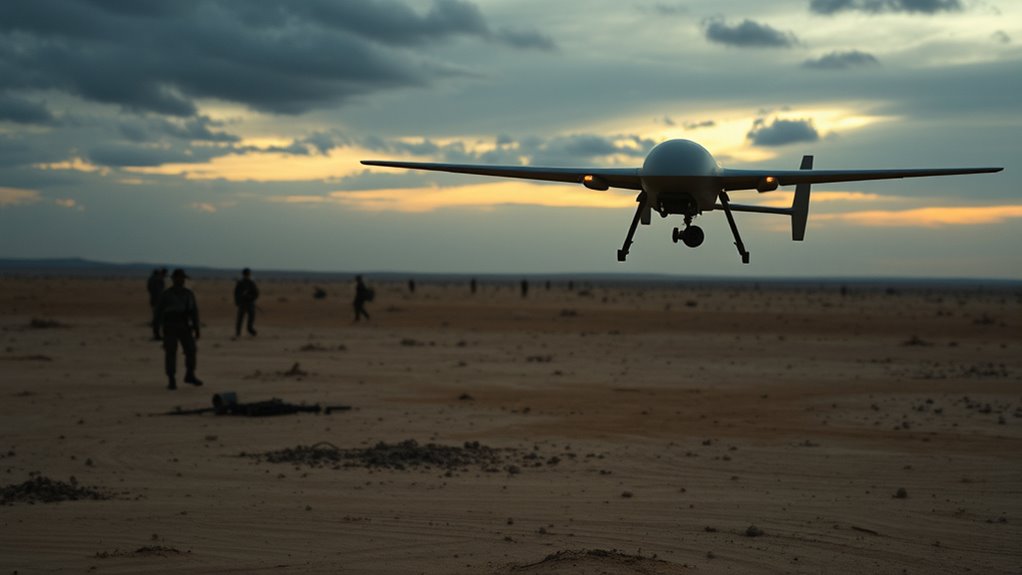
The lessons learned from the Yom Kippur War highlight a pressing need for innovation in intelligence operations.
AI can revolutionize how you analyze vast amounts of data, minimizing the information overload that hindered timely decision-making during the war. With machine learning algorithms, you can detect patterns in adversary communications and movements, which could predict coordinated attacks, like the recent surprise assault by Hamas.
In addition, AI enhances real-time threat analysis and early warning systems, addressing the strategic confusion that affected Israeli intelligence in 1973. By integrating AI into existing intelligence methods, you'll foster a thorough understanding of adversary intentions and capabilities, improving decision-making while reducing reliance on outdated inductive reasoning techniques.
Embracing AI could transform intelligence operations for the better.
How AI Could Address Analytical Methodology Gaps
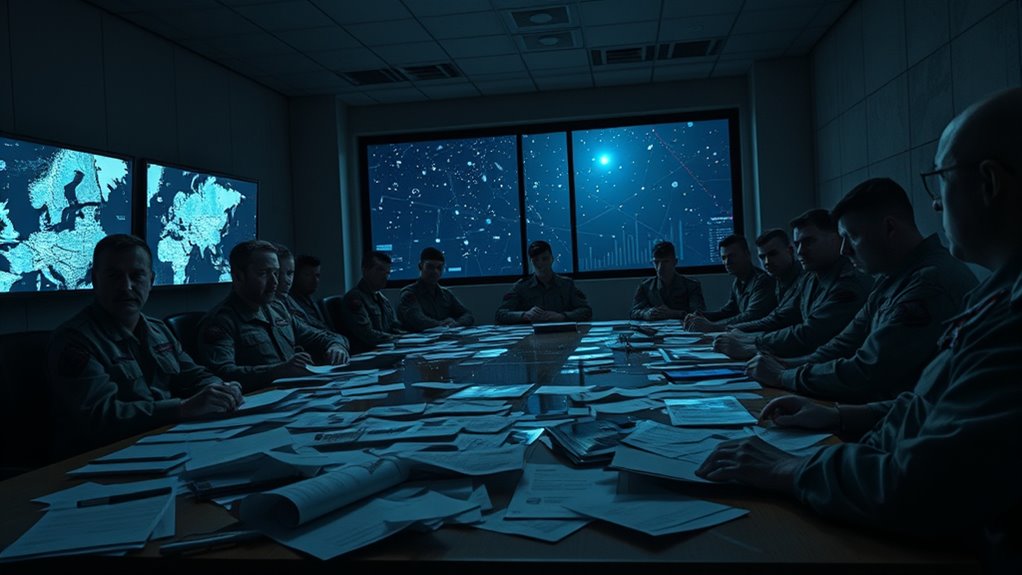
While traditional inductive reasoning has its merits, it often fails to capture the complexities of adversary behaviors, leaving gaps in analytical methodologies.
AI can address these intelligence failures from the Yom Kippur War by leveraging deductive reasoning and predictive analytics. By processing vast data sources, AI identifies patterns and anomalies that human analysts might miss, enhancing threat assessments and situational awareness.
Implementing AI tools can also mitigate the risk of groupthink by integrating diverse perspectives, fostering a more thorough understanding of adversarial intentions.
Additionally, machine learning algorithms can analyze historical events alongside real-time data, enabling intelligence agencies to adapt quickly to evolving threats and better anticipate potential attacks, greatly improving their overall analytical approach.
Proactive vs. Reactive Intelligence Strategies

In the domain of intelligence, anticipating threats effectively is essential for national security.
You'll see how proactive strategies can enhance data integration, allowing analysts to predict adversarial actions rather than merely reacting to them.
Anticipating Threats Effectively
Effective anticipation of threats hinges on the ability to adopt proactive intelligence strategies rather than relying solely on reactive measures. The Yom Kippur War exemplified this failure, as Israeli forces misjudged enemy capabilities and intentions. By leveraging AI, you can enhance data analysis and create a thorough threat landscape.
| Strategy Type | Description | Benefits |
|---|---|---|
| Proactive | Anticipates threats before they arise | Mitigates risks early |
| Reactive | Responds after incidents occur | Often leads to missed opportunities |
| AI-Enhanced | Processes vast data for insights | Identifies emerging patterns quickly |
Incorporating diverse data sources allows for continuous threat assessments, ensuring you stay ahead of evolving geopolitical dynamics. The advancements in AI integration in healthcare demonstrate the potential of AI to improve accuracy and predict trends across various fields.
Enhancing Data Integration
To enhance data integration in intelligence strategies, you need to prioritize proactive measures that draw from a wide array of sources like human intelligence, signals intelligence, and open-source information.
This proactive approach helps create a thorough threat landscape, allowing you to anticipate adversary behavior instead of merely reacting after an incident. Historical intelligence failures, such as those during the Yom Kippur War, show the pitfalls of relying solely on reactive strategies.
Future Implications for Israeli National Security

As you consider the future of Israeli national security, it's clear that AI-driven threat analysis could transform how intelligence is gathered and interpreted.
By enhancing collaboration across intelligence agencies, you can guarantee a more thorough understanding of emerging threats.
Embracing these technologies won't only improve situational awareness but also bolster proactive measures against potential risks.
AI-Driven Threat Analysis
While the lessons of the Yom Kippur War highlight the need for vigilance in national security, AI-driven threat analysis promises to transform how Israel anticipates and responds to potential conflicts.
By leveraging big data and predictive modeling, you can enhance early warning systems, improving your ability to detect patterns and anomalies in adversary movements.
Implementing machine learning algorithms allows for real-time processing of intelligence, providing actionable insights that combat complacency rooted in past successes.
Additionally, analyzing historical data alongside socio-political dynamics enables better assessments of adversaries like Hamas.
This integration of AI capabilities equips you to adapt to evolving threats, ensuring that Israel's intelligence remains agile and effective in preempting potential attacks before they escalate.
Furthermore, incorporating air quality considerations into strategic planning can improve overall operational effectiveness in urban environments where conflicts may arise.
Enhanced Intelligence Collaboration
The integration of AI-driven threat analysis sets the stage for enhanced intelligence collaboration between Israel and U.S. agencies, addressing the historical challenges faced during the Yom Kippur War.
By improving threat assessments and overcoming cultural clashes and differing analytical methodologies, both nations can better predict and respond to emerging threats.
A structured framework for intelligence sharing, as suggested by the Agranat Commission, fosters critical thinking and minimizes reliance on intuitive reasoning.
Leveraging AI for data analysis streamlines processes, while a multi-agency approach guarantees diverse perspectives enhance strategic warnings.
Continuous training and joint exercises focused on real-time scenarios will strengthen operational readiness, guaranteeing both intelligence communities are prepared for unexpected challenges in the future.
Frequently Asked Questions
What Were the Key Events Leading to the Yom Kippur War?
To understand the key events leading to the Yom Kippur War, you need to reflect on rising tensions between Israel and its Arab neighbors.
The 1967 Six-Day War left Israel in control of territories like the Golan Heights and West Bank, causing resentment. Egypt and Syria sought to reclaim lost land.
Diplomatic efforts, like the Khartoum Resolution, failed to resolve issues, pushing both sides toward conflict.
In October 1973, the situation escalated, igniting the war.
How Did the Israeli Leadership Respond to the Intelligence Failures?
It's ironic, isn't it? When faced with intelligence failures, Israeli leadership initially downplayed the warnings, believing their military superiority was unassailable.
They rushed to dismiss dissenting voices, sticking to their confidence in past successes.
Once the war erupted, however, they scrambled to adapt, overhauling their intelligence assessments and strategies.
This stark shift revealed their vulnerability, forcing them to confront the flaws in their reliance on outdated perceptions and assumptions.
What Technologies Existed During the Yom Kippur War for Intelligence Gathering?
During the Yom Kippur War, you'd find various technologies for intelligence gathering, including aerial reconnaissance, ground surveillance teams, and radio intercepts.
Israel relied heavily on its aircraft, like the Phantom jets, to capture images and gather data.
You'd also see the use of human intelligence (HUMINT) from spies and informants.
However, despite these technologies, gaps in analysis and interpretation often led to critical oversights in understanding enemy movements and intentions.
Were There Any Significant Intelligence Successes During the War?
Yes, there were significant intelligence successes during the Yom Kippur War.
You'd find that Israeli intelligence managed to intercept key communications and gather vital information about enemy troop movements. This allowed them to understand the scale of the attack and respond accordingly, despite initial failures.
Additionally, their ability to analyze aerial surveillance helped identify strategic locations. These successes played a vital role in shaping military strategies throughout the conflict.
How Has Military Intelligence Evolved Since the Yom Kippur War?
Since the days of the telegraph, military intelligence has dramatically evolved.
You'll notice advancements in technology, data analysis, and real-time communication. Drones and satellites provide unprecedented surveillance capabilities, while AI algorithms crunch vast amounts of data to predict enemy movements.
Intelligence-sharing among allies has improved collaboration, making operations more efficient.
You're witnessing a shift from traditional methods to a reliance on cutting-edge technologies that enhance strategic decision-making in modern warfare.
Conclusion
In the high-stakes game of intelligence, learning from past mistakes is essential. The Yom Kippur War taught us that misjudging adversaries can lead to significant consequences. By harnessing AI, you can bridge the gaps in analytical methods and transform reactive strategies into proactive ones. As the saying goes, "an ounce of prevention is worth a pound of cure." Embracing these advancements can bolster Israel's national security and guarantee that history doesn't repeat itself.






